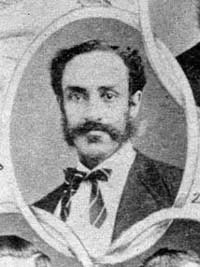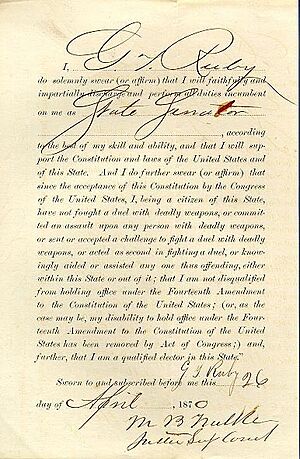George Ruby facts for kids
Quick facts for kids
George Thompson Ruby
|
|
|---|---|
 |
|
| Texas State Senator from District 12 (Brazoria, Galveston, and Matagorda Counties) | |
| In office February 8, 1870 – January 13, 1874 |
|
| Succeeded by | Benjamin Cromwell Franklin |
| Personal details | |
| Born | 1841 New York City, U.S. |
| Died | October 31, 1882 New Orleans, Louisiana, U.S. |
| Political party | Republican |
| Occupation | Journalist, Teacher |
George Thompson Ruby (1841-1882) was a very important African American leader in Texas during a time called the Reconstruction era. This was the period after the American Civil War (1865-1877). He was a member of the Republican Party.
Born in New York City, he grew up in Portland, Maine. Before the Civil War ended, he worked in Boston and Haiti. He then became a teacher in New Orleans, Louisiana. In 1866, he moved to Galveston, Texas. There, he worked for the Freedmen's Bureau, an agency that helped formerly enslaved people.
Ruby also helped start the new Republican Party in Texas. He was one of ten African Americans elected to the state's constitutional convention in 1868-1869. He also served in the Texas Senate. He was a delegate to two Republican Party national meetings. At the first one, he was the only African American delegate from Texas. He also helped organize labor unions, even starting and leading the Texas Colored Labor Convention. After white Democrats took control of the Texas government in 1874, he returned to New Orleans. There, he worked as a journalist.
Contents
George Ruby's Early Life and Work
Ruby was born in New York City in 1841. His parents were likely Rev. Ebenezer Ruby and Jemima Ruby. He grew up with his family near Portland, Maine, where he went to school.
In 1860, as a young man, he moved to Boston. He worked as a writer for a newspaper called Pine and Palm. This paper was run by James Redpath. Ruby was sent to Haiti as a correspondent. Redpath's paper supported a plan to encourage African Americans to move to Haiti. This plan was not very successful, and Ruby returned to the United States in 1862.
Helping Freed People in the South
In January 1864, Ruby moved to Louisiana. He started teaching school in a Baptist church in New Orleans. As the Union army took control of more areas, he taught in St. Bernard's Parish. After the war, the army stopped running schools. Ruby then worked for the American Missionary Association, teaching in New Orleans.
When the Freedmen's Bureau started its schools, he was hired to teach there too. In 1866, he went to Jackson, Louisiana, to open a Bureau school. However, a group of white people attacked him and tried to force him out.
A Leader in Texas Politics
In September 1866, schools in Louisiana faced money problems. So, Ruby moved to Texas. The Freedmen's Bureau sent him to Galveston as an agent and teacher. Many black teachers from Louisiana moved to Texas.
Ruby worked to set up and run schools for African Americans. He also helped organize local groups of the Union League. This group was important for getting support for the new Republican Party. In 1868, he became the League's first state president, which was a powerful political job. Later that year, he was the first African American from Texas to attend the Republican National Convention. He also became the editor of a newspaper called the Galveston Standard.
Fighting for Civil Rights
The governor of Texas, Elisha M. Pease, made Ruby a notary public in Galveston. In 1868, elections were held for people to write a new state constitution. Ruby was chosen to represent the areas of Brazoria, Galveston, and Matagorda counties. He was one of ten African Americans elected to this convention.
Ruby joined the more progressive side of the Republican Party. He was worried about some of the compromises made in the new constitution. He tried to get the national government to reject it. But in the end, he accepted it. He believed it was the best way to keep a Republican government in power. He felt that equal rights for black people in Texas depended on a Republican government.
In 1870, Ruby was elected to the Texas Senate by a very close vote. He served two terms, from 1870-71 and again in 1873. He worked hard for laws that would protect the civil rights of freed people. One bill he supported would have opened public transportation to everyone, no matter their race. However, white members made sure this bill never got voted on.
Ruby also supported building railroads from Galveston. This was important for his mostly white voters. He was also appointed as a customs officer in Galveston in 1869. He had strong connections to labor groups in Galveston. As president of the Texas Colored Labor Convention in 1869, he had a lot of influence. He also helped black workers get jobs at the Galveston docks after 1870. One historian called Ruby "the most important black politician in Texas during Reconstruction."
He was very good at getting Republican voters to support his ideas. He especially helped black voters across Texas. Historian Barry A. Moneyhon wrote that "no black man in Texas exercised more political power than did George Thompson Ruby." He was a strong supporter of civil and political rights for his race. He knew when to make compromises to reach his bigger goals. He worked carefully with white politicians to create more chances for black people.
Return to Louisiana and Journalism
In 1874, the Democrats returned to power in Texas. Ruby then left Texas and went back to Louisiana. He found work at the New Orleans Louisianian. This was a black Republican newspaper edited by Pinckney B. S. Pinchback, who was Louisiana's former lieutenant governor.
Ruby also got a job in the New Orleans custom-house. But his main work was with newspapers. He worked with Pinchback's paper until 1878. That year, he became the editor of the New Orleans Observer, a newspaper he started. He ran it through the 1880 election. After that paper closed, he started another one called the New Orleans Republic.
In the late 1870s, Ruby strongly supported the Exoduster movement. This movement encouraged formerly enslaved people to move from the Deep South to Kansas. They wanted to escape unfair rules, violence, and white supremacy.
George Ruby was still an important voice for black interests in Louisiana. He died on October 31, 1882, from malaria at his home in New Orleans.


